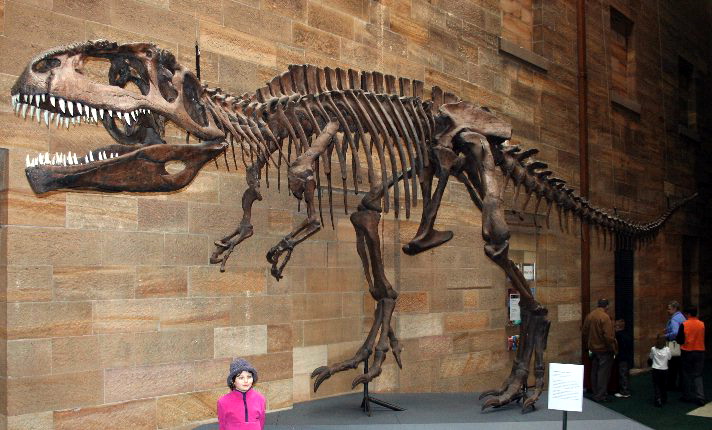|
| 질의: Dinosaur | 결과: 388번째/1083 | |
Giganotosaurus - Wiki
| 제목: | Giganotosaurus - Wiki
| |

| 해상도: 712x430
파일크기: 116446 Bytes
촬영일: 2007:08:16 23:48:48
등록시간: 2007:08:16 23:51:27
|
Giganotosaurus
From Wikipedia, the free encyclopedia
[Photo] Giganotosaurus carolinii skeleton replica, Australian Museum in Sydney. Photo by Cas Liber.
Fossil range: mid Cretaceous
Giganotosaurus (meaning 'giant southern lizard', derived from the Ancient Greek gigas/γιγα?? meaning 'giant', notos/νοτο?? meaning 'south wind' and saurus/σαυρο?? meaning 'lizard') was a genus of carcharodontosaurid dinosaur that lived 93 to 89 million years ago during the Turonian stage of the Late Cretaceous Period. It is one of the largest known terrestrial carnivores, longer than Tyrannosaurus, but smaller than Spinosaurus. Its fossils have been found in Argentina.
Discovery and species
Giganotosaurus carolinii was named for Ruben Carolini, an amateur fossil hunter, who discovered the fossils in the deposits of the Rio Limay Formation of Patagonia, southern Argentina, in 1993. It was published by Rodolfo Coria and Leonardo Salgado in the journal Nature in 1995.
The holotype specimen's (MUCPv-Ch1) skeleton was about 70% complete and included the skull, pelvis, leg bones and most of the backbone. A second specimen (MUCPv-95), 8% larger, has also been recovered. The largest Giganotosaurus found is estimated to be 13.7 m (45 ft) long, and weighed 5.2 tons. The specimen's skull was the size of a bathtub, measuring 1.95 m (6 ft 5 in). Giganotosaurus surpasses Tyrannosaurus rex in length by almost 2 m.
Paleobiology
G. carolinii was larger than T. rex but had a much smaller brain that was the size and shape of a banana. A well-developed olfactory region means it probably had a good sense of smell.
Titanosaur fossils have been recovered near the remains of Giganotosaurus, leading to speculation that these carnivores may have preyed on the giant herbivores. Fossils of related carcharodontosaurid fossils grouped closely together may indicate pack hunting, a behavior that could possibly extend to Giganotosaurus itself.
Classification
Giganotosaurus, along with relatives like Tyrannotitan, Mapusaurus and Carcharodontosaurus, are members of the carnosaur family Carcharodontosauridae. Both Giganotosaurus and Mapusaurus have been placed in their own subfamily Giganotosaurinae by Coria and Currie in 2006 as more Carcharodontosaurid dinosaurs are found and described, allowing interrelationships to be calculated.
Popular Culture
The original fossils of Giganotosaurus remain at the Carmen Funes Museum in Neuquen, Argentina, but replicas are common in other places, including the Australian Museum in Sydney. Despite having been discovered relatively recently, Giganotosaurus is already gaining a name for itself in popular culture. Giganotosaurus appears in the Walking with Dinosaurs special Land of Giants. They are seen to hunt both independently and in packs, working together to bring down an Argentinosaurus. Giganotosaurus is also featured in the IMAX movie Dinosaurs: Giants of Patagonia where Dr. Rodolfo Coria shows the sites of major discoveries in Argentina.
The PlayStation game Dino Crisis 2 features a Giganotosaurus as the final boss. However, the size of the Giganotosaurus in the game was exaggerated and is much larger than in real life. In the game it is portrayed as being over 20 meters long and over 7 meters tall, while in real life it was, at most, 14 meters long and 5.5 meters tall.
http://en.wikipedia.org/wiki/Giganotosaurus
| The text in this page is based on the copyrighted Wikipedia article shown in above URL. It is used under the GNU Free Documentation License. You may redistribute it, verbatim or modified, providing that you comply with the terms of the GFDL. |
|
^o^
동물그림창고 똑똑전화 누리집
^o^
|
|